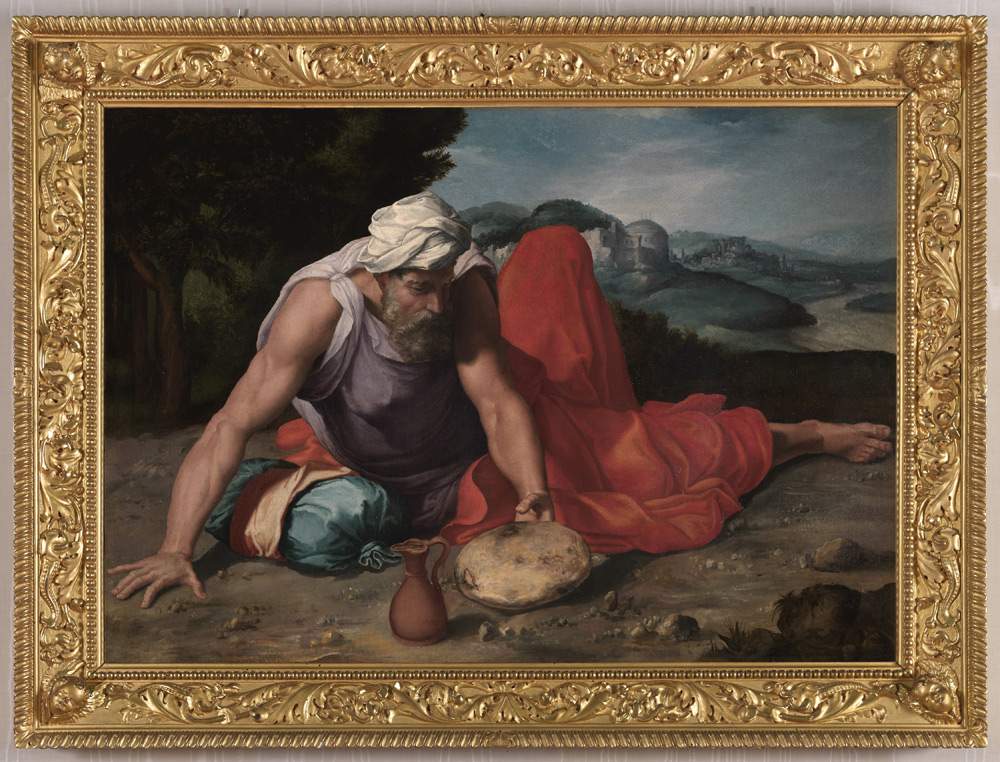A new acquisition for the Uffizi Gallery in Florence: the Tuscan museum has in fact succeeded in bringing to its collections a masterpiece by Daniele da Volterra (real name Daniele Ricciarelli, Volterra, 1509 - Rome, 1566),Elijah in the Desert, painted around 1543. It is a work that features a rare iconography taken from the Book of Kings (chapter 19), where the prophet Elijah, during his own meditation in the desert, is said to receive the food on which he was nourished from an angel who had taken care of him (and in this case the flatbread and jug that Elijah has with him recall the theme of the Eucharist, which was particularly important in the age of the Counter-Reformation). It is a painting that reveals clear Michelangelo ancestry (shapes and colors are suggested by the example of the Sistine Chapel frescoes) but also Raphaelesque (especially in the landscape).
The painting belonged to the collection of the Pannocchieschi d’Elci family of Siena, and together with another painting by Daniele da Volterra from the same collection, the Madonna and Child, St. John and St. Barbara of slightly later date, it had been exhibited last year at the exhibition Daniele da Volterra. The d’Elci Paintings, held at the Galleria Nazionale di Palazzo Corsini in Rome(here our review, with more information about the work: moreover, in that same article we advocated the purchase of the work, which was on the market, by the state). However, the work had also been the protagonist of other exhibitions: for example, the monographic Daniele da Volterra, friend of Michelangelo at Casa Buonarroti (Florence) between 2003 and 2004, or the recent exhibition L’Eterno e il tempo tra Michelangelo e Caravaggio held at the San Domenico Museums in Forlì in early 2018. The painting will be destined for the sixteenth-century rooms and will significantly enrich the Uffizi collection.
The acquisition was presented by the director of the Uffizi, Eike Schmidt together with Anna Di Bene, superintendent of Siena, Grosseto and Arezzo, Alessandro Bagnoli, an official of the same Superintendency, and two scholars who are experts on Daniele da Volterra and who have devoted several studies to the newly acquired work, namely Barbara Agosti, an associate of Museology and Art Criticism and Restoration at the University of Rome “Tor Vergata,” and Vittoria Romani, a professor of art history at the University of Padua.
“In 1979,” Barbara Agosti pointed out, “the then Superintendency for the Historical and Artistic Heritage of Siena and Grosseto proposed a bond for the two extraordinary paintings by Daniele da Volterra, which came from the painter’s house (Madonna and Child, St. John and St. Barbara and Elijah in the Desert). This now distant administrative act has finally borne fruit, as it forms the basis of today’s entry of the Elijah in the Desert into the Uffizi collection, an acquisition that the Territorial Office of Protection has in every way favored.”
“With the new Michelangelo room recently opened,” said Eike Schmidt, “the timing of the purchase of Daniele da Volterra’s masterpiece could not be better. In fact, in the new spaces dedicated to 16th-century painting, which we are currently preparing, the Elijah in the Desert will have a place of honor next to the Massacre of the Innocents (1557) already ab antiquo in the Medici collections, also a rarity among the paintings on panel or canvas that have come down to us (fewer than ten) by the hand of the master, a very dear friend of Michelangelo, whose sculptural gravitas he interprets in an exemplary manner.”
 |
| New addition for the Uffizi, a masterpiece by Daniele da Volterra arrives |
Warning: the translation into English of the original Italian article was created using automatic tools. We undertake to review all articles, but we do not guarantee the total absence of inaccuracies in the translation due to the program. You can find the original by clicking on the ITA button. If you find any mistake,please contact us.